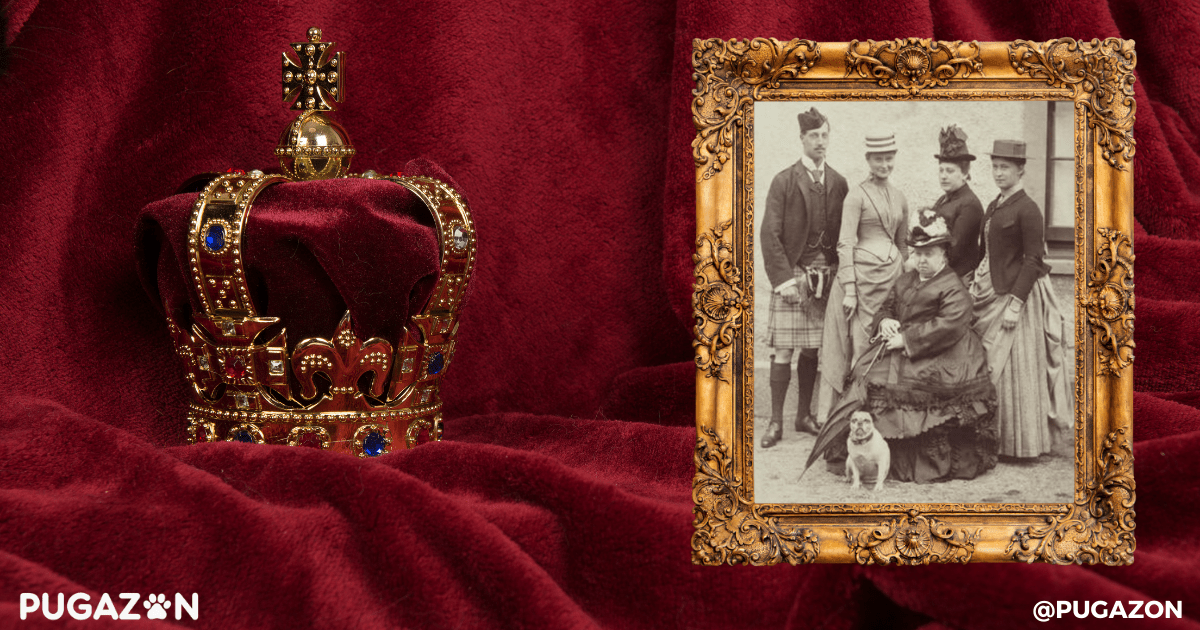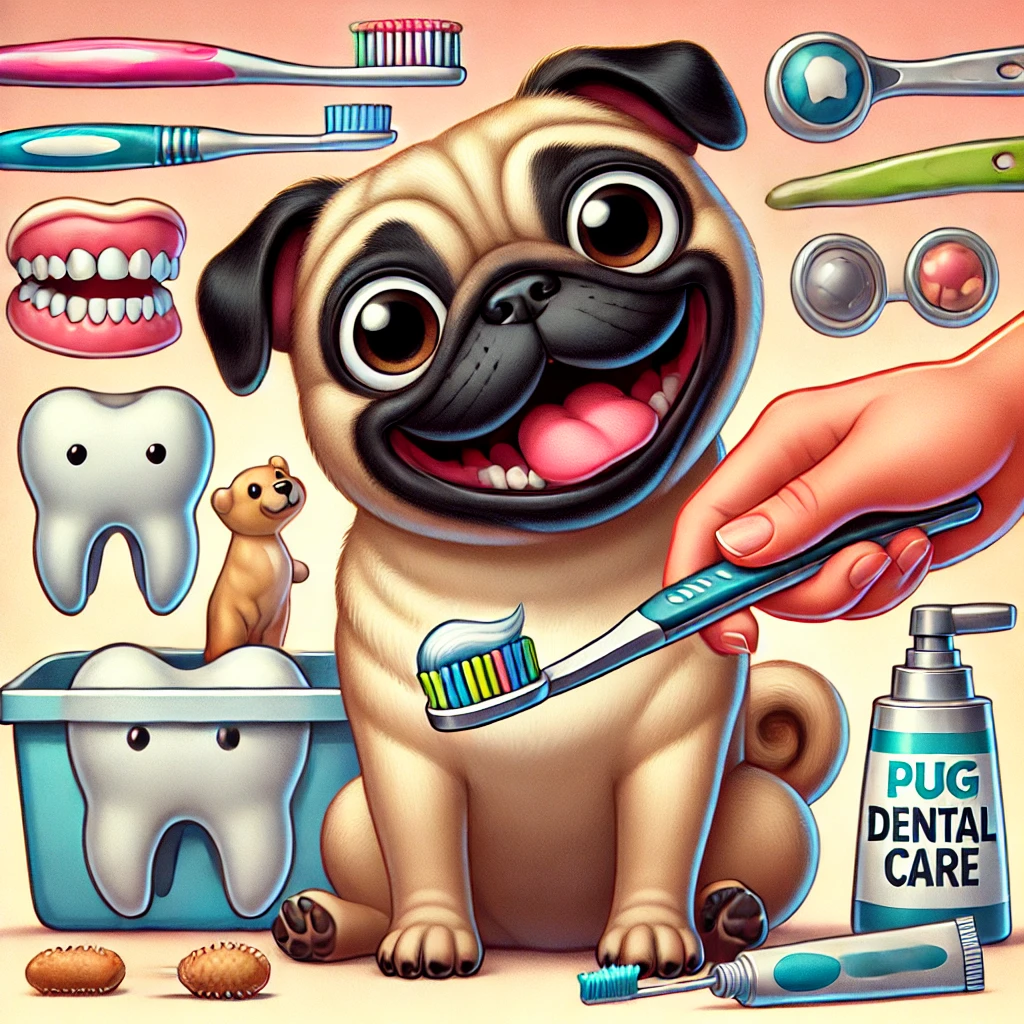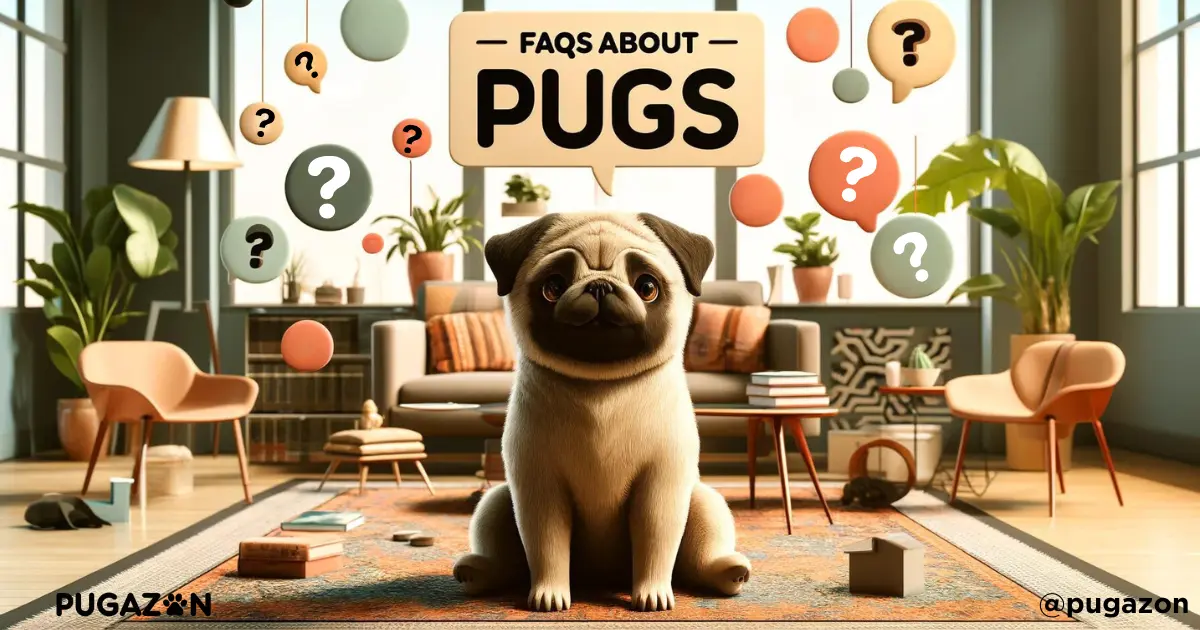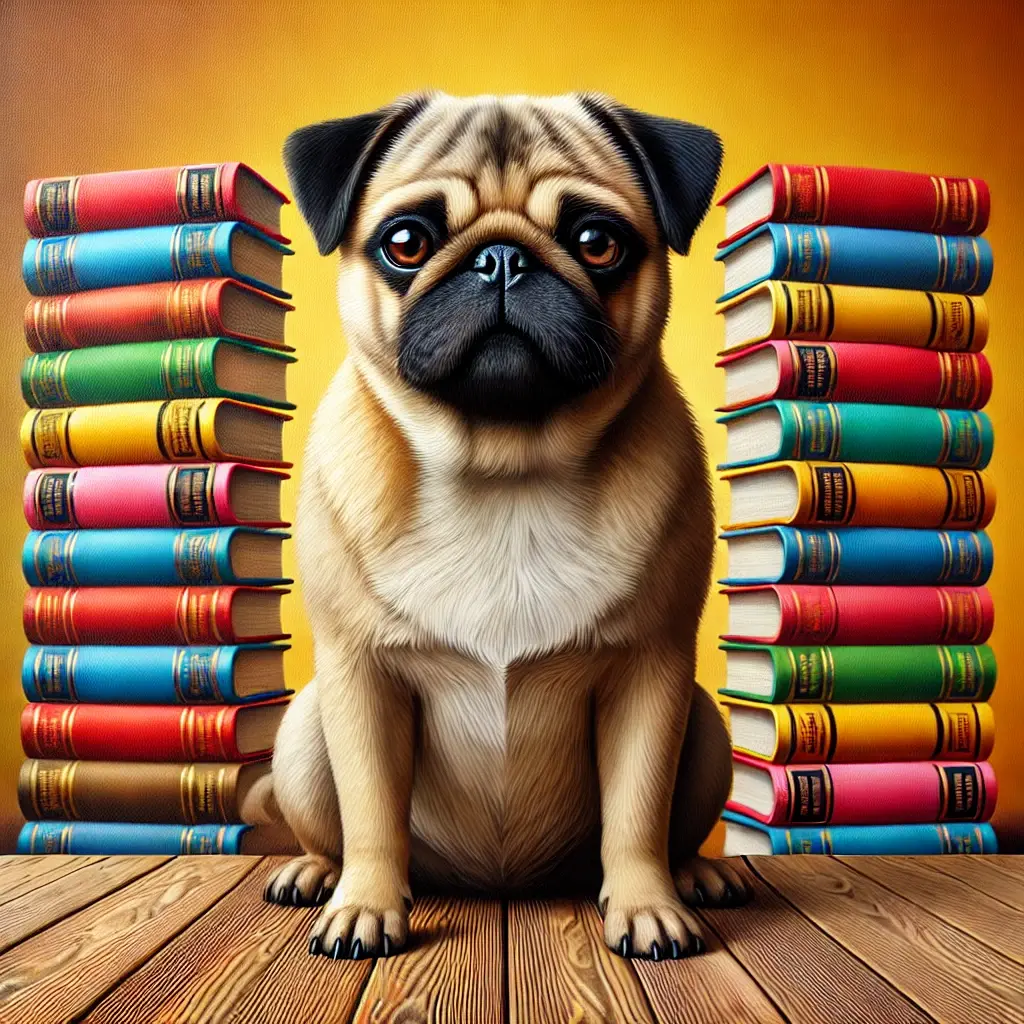Iconic Pugs in History
Throughout history, pugs have played an important role as loyal companions to royalty, aristocrats, and, in more recent times, pop culture icons and social media stars. Across the decades and cultures there have been quite a few iconic pugs in history and this blog post aims to delve into a few notable pugs.
Why pugs? Their distinctive appearance, characterized by their wrinkled faces, short muzzles, and curly tails, has made them one of the most recognizable dog breeds in the world. But beyond their unique looks, iconic pugs in history have left an indelible mark on the world, from the imperial courts of China to the royal palaces of Europe.
Pug history dates back to over 2,000 years ago, with the breed originating in ancient China. There, pugs were bred to serve as loyal companions to emperors and their families, often living luxurious lives within the emperor’s palace. These dogs were highly valued and were even given their own guards for protection. Over time, through trade and diplomacy, pugs made their way to Europe in the 16th century, where they quickly became the favored pets of nobility, particularly in countries like Holland, France, and England.
By the 19th century, pugs had become an essential part of European aristocracy, with their presence seen in royal courts and famous artworks alike. They were seen as symbols of wealth, loyalty, and elegance, often associated with kings, queens, and influential figures in society. This blog post will explore the rich history of famous pugs who have shaped the breed, from their roles in royal breeding programs to their influence on modern pug breeding lines.
Each section of this blog will delve into the individual legacies of iconic pugs, such as Lamb and Moss, whose bloodlines shaped modern pugs, and Pompey, whose heroic actions saved the life of Prince William of Orange. Through these stories, we’ll understand how historical pugs not only influenced royalty but also left an everlasting mark on the world, creating the foundation of the breed we know today.
Historical Pugs and Their Legacies
The history of iconic pugs is filled with stories of historical pugs whose legacies have influenced the breed for centuries. From their early days in China, where they were companions to emperors, to their rise in European courts, where they were beloved by royalty, these famous pugs in history have left their mark not only on the breed but on the world.
As these pugs spread across Europe, they became integral to pug breeding history, particularly in England and America, where their bloodlines were carefully cultivated. Lamb and Moss, two foundational pugs brought from China to England, played an essential role in establishing the modern pug breed, while Punch and Terry laid the groundwork for the famous Morrison pug lines. These historical figures helped ensure that the defining traits of pugs—wrinkled faces, curly tails, and compact bodies—were passed down through generations.
In this section, we will explore the stories of these iconic pugs in history and how their legacies have shaped the pug breed as we know it today.
Lamb and Moss: The Forefathers of Modern Pug Lines

When discussing the foundation of modern pug breeding lines, the names Lamb and Moss hold a place of special significance. These two iconic pugs in history, were allegedly taken from an Emperor’s Palace in China and brought to England in the early 19th century. These two mischievous characters are widely regarded as the forefathers of modern pug lines in both England and America.
Before the arrival of Lamb and Moss, pugs were relatively rare in England. However, their introduction changed the course of pug breeding forever. Lamb and Moss were bred with the goal of preserving their distinctive traits, such as their short muzzles, wrinkled faces, and compact bodies. Their unique appearance and temperament quickly caught the attention of breeders, who sought to maintain and replicate these features in future generations.
The offspring of Lamb and Moss went on to form the basis of many influential breeding lines, including the Morrisonand Willoughby lines, both of which are still revered by breeders today. Their descendants spread across England and America, establishing the pug’s signature characteristics as the standard for the breed. The legacy of Lamb and Moss can still be seen in modern pugs, as many of today’s most well-known pug lines can trace their ancestry back to these two pugs.
The role that Lamb and Moss played in shaping the pug breed cannot be overstated. Their contribution to the establishment of pug breeding lines set the standard for pug appearance and temperament, and their influence is still felt in breeding programs worldwide. These two truly were iconic pugs in history.
Fun Fact: Lamb and Moss were considered so valuable that their descendants were often gifted to European nobility, further cementing the pug’s status as a symbol of wealth and luxury in the 19th century.
Click the Pug: The Progeny of Lamb and Moss
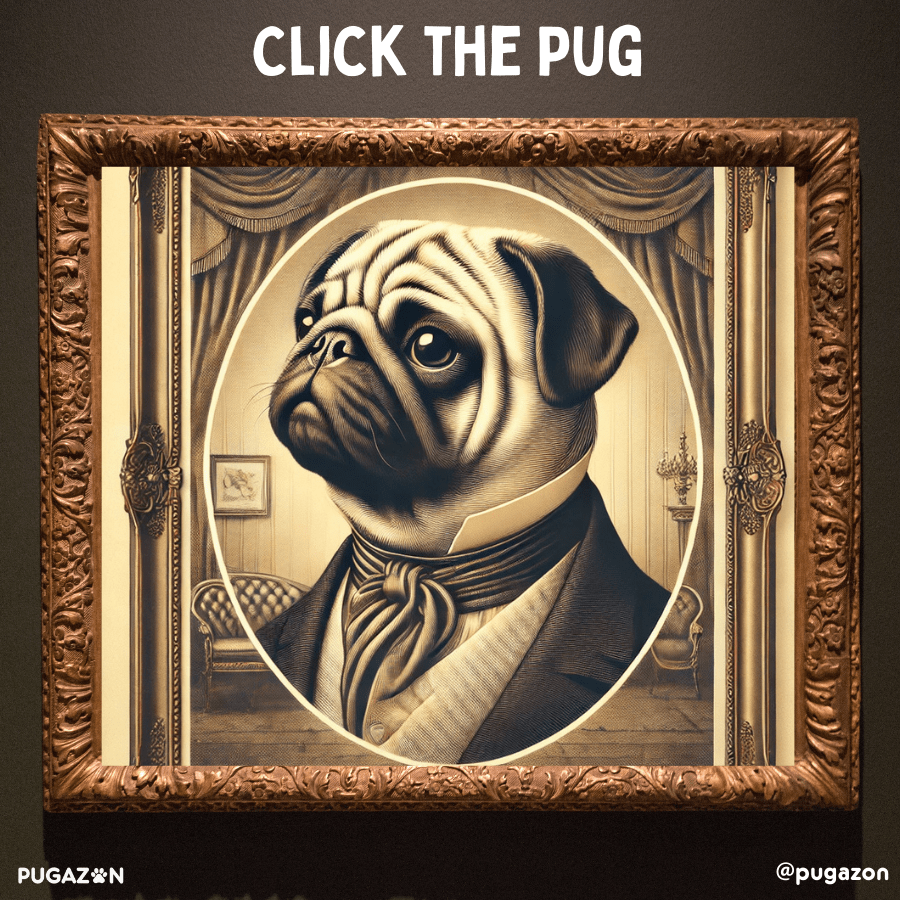
Click the pug is one of the most well-known descendants of Lamb and Moss and played a pivotal role in shaping the modern pug breed. As the progeny of two of the most important historical pugs, Click inherited the best traits of his parents and went on to become a key figure in the development of pug breeding lines throughout England and America.
Born in 19th-century England, Click’s physical traits—wrinkled face, short snout, compact body, and curled tail—made him an ideal specimen for breeding. Breeders sought to replicate these features, which had become synonymous with the breed, and Click’s descendants were in high demand across Europe and America.
Click’s lineage was particularly influential in the formation of the Morrison pug lines, one of the most prestigious pug breeding lines in the world. His offspring carried forward the characteristics that define the pug breed today, ensuring that these traits were passed down through generations. Thanks to Click, the pug breed we know today has remained consistent in appearance and temperament, making him one of the most iconic pugs in history.
Fun Fact: Click was so highly regarded that breeders from around the world sought his offspring to include in their breeding programs, solidifying his place as a key figure in pug breeding history.
Last update on 2025-02-11 / * Affiliate links / Image source: Amazon Product Advertising API
Punch and Terry: The Foundation of the Morrison Lines

Punch and Terry were two iconic pugs in history that laid the foundation for the Morrison pug lines, one of the most respected breeding lines in pug history. Descended from the Lamb and Moss lineage, Punch and Terry helped establish the Morrison family’s reputation for breeding high-quality pugs known for their wrinkled faces, short snouts, and compact bodies.
The Morrison line quickly gained fame across England and Europe, with aristocrats and pug enthusiasts seeking to obtain pugs from this prestigious line. Punch and Terry’s descendants helped shape the breed’s modern characteristics, and their influence spread to American pug lines as well.
Fun Fact: Mops and Nell were not only influential in the development of the Willoughby lines but were also known for their affectionate personalities, making them favorites among aristocrats in 19th-century England.
Royal Iconic Pugs: Companions of Kings and Queens
Pugs have long been favored by royalty, becoming companions to some of the most powerful monarchs in European history. From their roles in the courts of Holland, France, and England, these royal pugs not only provided companionship but also served as symbols of wealth, loyalty, and status. Their popularity among the nobility helped solidify the breed’s position as a luxury pet, favored by kings, queens, and aristocrats alike.
Among the most iconic pugs in history are Pompey, who saved the life of Prince William of Orange, Fortune, who served as the trusted companion of Josephine Bonaparte, and Mops, the beloved pug of Marie Antoinette. These pugs not only became integral parts of royal families but also influenced the breed’s development by being part of prestigious breeding programs.
The role of royal pugs extended beyond simple companionship. In many cases, they were seen as protectors and trusted allies to their owners, with their loyalty becoming a defining trait of the breed. As we explore the stories of Pompey, Fortune, Mops, and others, we’ll discover how these royal pugs left a lasting legacy on both the pug breed and the royal families they served. These iconic pugs in history will be remembered across the ages.
Always Stay Up to Date
Pompey the Pug: The Heroic Pug Who Saved a Prince
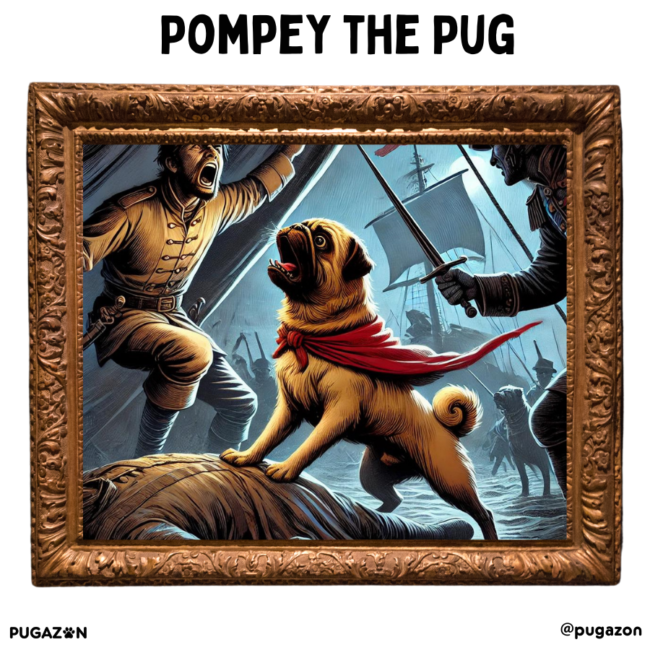
Pompey the Pug holds a unique place in pug history as a heroic figure who is credited with saving the life of Prince William of Orange during the Dutch Revolt in the 16th century. According to historical accounts, Prince William was resting in his tent when assassins approached under the cover of night. While everyone else in the camp slept, it was Pompey who detected the threat.
Pompey began barking and scratching at his master’s face, waking Prince William just in time to evade the attackers. The prince’s life was saved, and Pompey became known as the pug who saved a future monarch. This heroic act solidified Pompey’s place as one of the most famous royal pugs in history, and he became a symbol of loyalty and protection.
In recognition of his bravery, Pompey was honored by Prince William, and his story became part of the royal family’s lore. Pompey’s loyalty and bravery exemplify the key traits for which pugs are known: their unwavering devotion to their owners and their alertness in the face of danger. The story of Pompey the Pug remains one of the most well-known tales in pug history, highlighting the breed’s strong bond with humans.
Fun Fact: Pompey the Pug was so beloved by Prince William of Orange that he was buried at the prince's feet in the Church of St. Peter in Delft, Netherlands, with a sculpture of Pompey lying faithfully beside his master.
Fortune the Pug: Josephine Bonaparte’s Fierce Little Companion
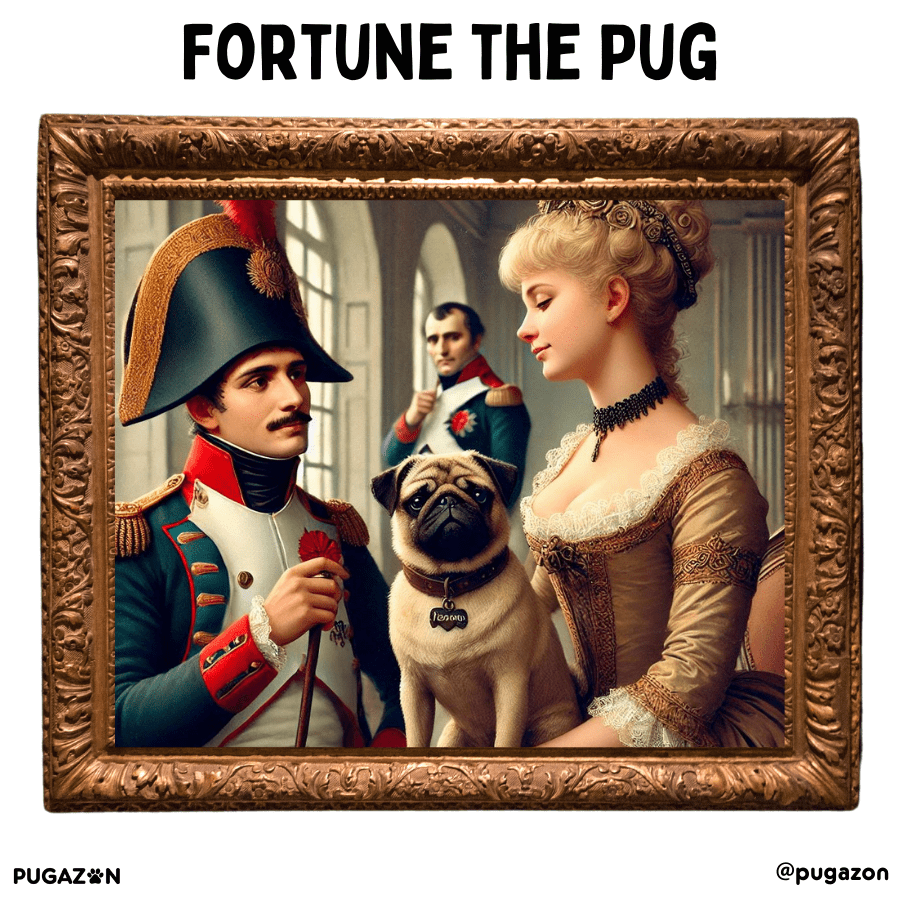
Fortune the Pug was no ordinary pet. He was the fiercely loyal companion of Josephine Bonaparte, wife of Napoleon Bonaparte and a woman of great influence in France during the late 18th and early 19th centuries. Fortune’s story is not only one of loyalty but also of intrigue, as he played a vital role in Josephine’s life during her imprisonment.
When Josephine was imprisoned during the Reign of Terror in 1794, Fortune was allowed to stay with her, providing her with much-needed comfort and companionship. However, Fortune’s role went beyond simply being a pet—he was entrusted with carrying secret messages between Josephine and Napoleon during her imprisonment. Fortune’s small size and unassuming appearance made him the perfect courier for these covert exchanges, ensuring that communication remained open between the couple during a tumultuous time.
Fortune’s loyalty to Josephine was legendary, and his protective nature extended even to her marriage. It is said that on the wedding night of Josephine and Napoleon, Fortune refused to leave Josephine’s bed, much to Napoleon’s dismay. In fact, Fortune reportedly bit Napoleon, further demonstrating his unwavering devotion to his mistress.
Throughout Josephine’s life, Fortune the Pug remained by her side, a symbol of her strength and resilience. His role as her protector, both in physical and emotional terms, solidified his place in pug history. Fortune’s fierce loyalty and quick wit made him more than just a pet—he was a trusted companion who played a significant role in Josephine’s life during one of the most challenging periods of her life.
Fun Fact: Despite Napoleon’s initial annoyance with Fortune, Josephine kept a portrait of her beloved pug in her private chambers at Malmaison, a testament to the strong bond they shared.
Mops the Pug: The Aristocratic Companion of Marie Antoinette
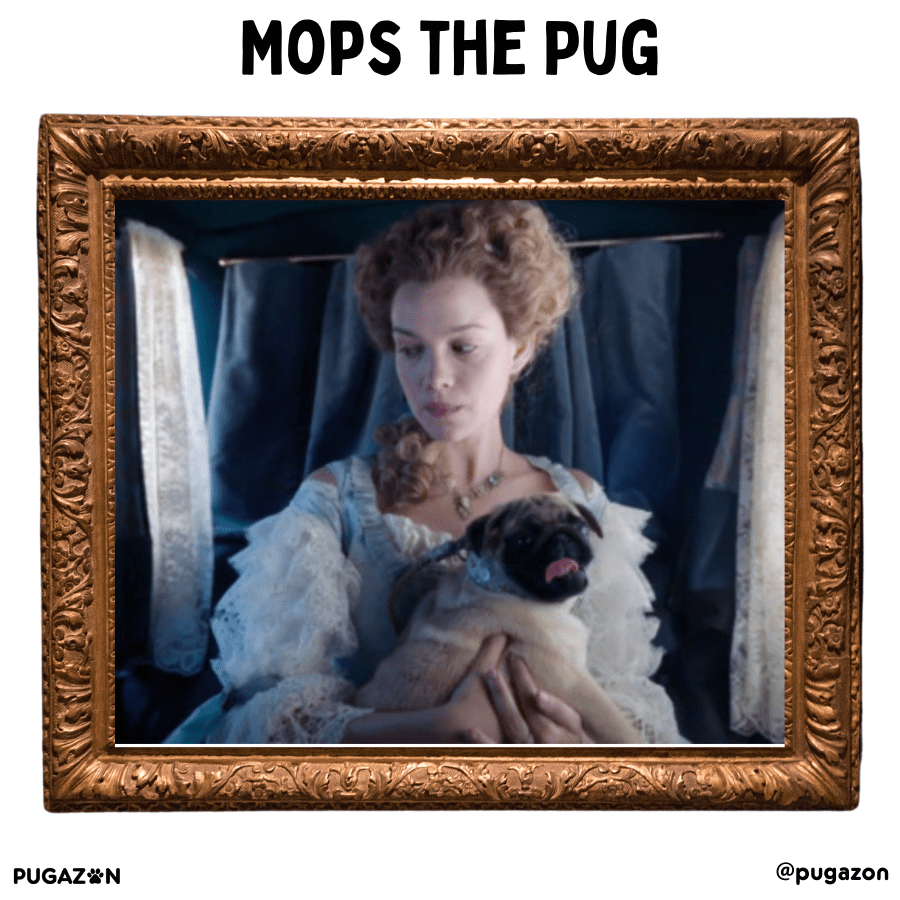
Mops the Pug was the cherished companion of Marie Antoinette, the ill-fated Queen of France. Before her marriage to Louis XVI, Marie Antoinette kept Mops by her side as she journeyed from her native Austria to France, where she would take up her new role as queen. During this time of great change and uncertainty, Mops provided her with comfort and a sense of familiarity.
In the lavish court of Versailles, Mops quickly became a part of Marie Antoinette’s entourage, accompanying her to royal events and even living with her in the palace. The pug’s role as a royal companion was symbolic of Marie Antoinette’s own position—elegant, beloved, and yet destined for a tragic end.
Mops, like other royal pugs of the time, was treated with great care, receiving the best food, grooming, and attention that 18th-century France could provide. Pugs were seen as symbols of luxury and refinement, and Mops was no exception. His presence in the French royal court reflected the pug’s growing status as a fashionable and aristocratic pet.
Though Marie Antoinette’s life ended tragically during the French Revolution, the legacy of Mops remains. He is remembered as the queen’s loyal companion, a symbol of the opulence and grandeur of the Ancien Régime. His story highlights the enduring appeal of pugs as royal companions, even in times of great political upheaval.
Fun Fact: Marie Antoinette was so attached to Mops that when she traveled from Austria to France to marry Louis XVI, she sent for Mops to be brought to her new home, ensuring that her beloved pug would always be with her.
The Pugs of Queen Victoria: A Legacy of Royal Affection
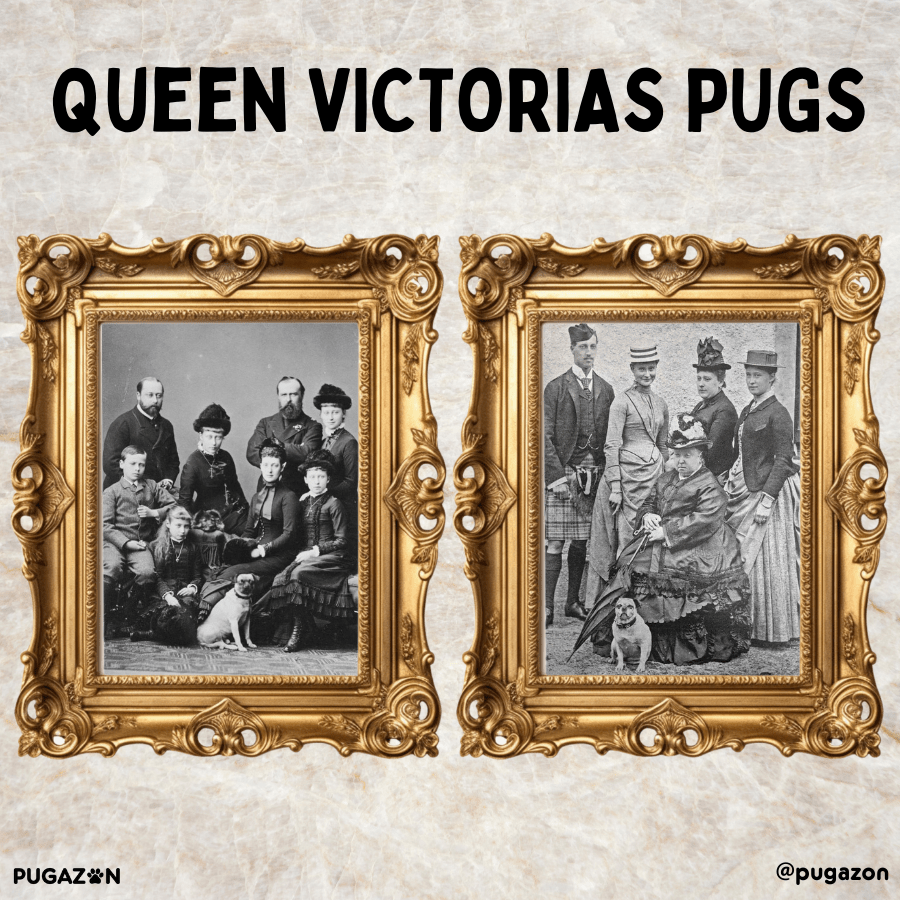
Queen Victoria, one of the most influential monarchs in British history, was also a great lover of pugs. Her reign in the 19th century not only left a lasting mark on Britain but also had a profound impact on the pug breed. Queen Victoria’s fondness for pugs helped popularize the breed among British aristocracy, and her own pugs played a significant role in shaping the modern pug’s appearance and temperament.
Among Queen Victoria’s many pugs, some of the most notable were Minka, Olga, Pedro, Fatima and Venus, all of whom were loved, especially Minka who came from Russia. Queen Victoria was particularly interested in breeding pugs, and she took an active role in ensuring that her pugs were healthy and well-bred. Her influence on pug breeding standards during the Victorian erawas immense, as she helped to refine the breed’s distinctive features, including the short muzzle, curly tail, and compact body.
Queen Victoria’s passion for pugs extended beyond her own personal pets. She often gave pugs as gifts to members of the royal family and to foreign dignitaries, further increasing the breed’s popularity across Europe. The Victorian era saw a surge in the popularity of pugs, and much of this can be attributed to Queen Victoria’s own love for the breed.
The legacy of Queen Victoria’s pugs continues to this day, as her influence on the pug breed helped to establish many of the characteristics we associate with modern pugs. Her role in promoting the breed ensured that pugs would remain a favorite among royalty and the aristocracy for generations to come.
Fun Fact: Queen Victoria’s love for pugs was so strong that she personally oversaw the breeding of her dogs, ensuring that they met her exacting standards for health, appearance, and temperament.
The Royal Pugs of the Duke and Duchess of Windsor

The love of pugs was not lost on Edward VIII, better known as the Duke of Windsor, and his wife, Wallis Simpson, the Duchess of Windsor. Known for their glamorous and sometimes controversial lives, the Duke and Duchess had a deep affection for pugs, a breed that became synonymous with their luxurious lifestyle.
The Windsor pugs, were frequent companions with the couple and could often be seen in photographs and portraits, a testament to their importance in the lives of the Duke and Duchess. Wallis Simpson especially adored her pugs and was rarely seen without one of them by her side. In fact, their pugs accompanied them on their many travels around the world, living a life of luxury, which included private attendants and the finest accommodations.
The Windsor pugs symbolized more than just companionship. For the Duke and Duchess, their pugs represented loyalty during a time when the couple faced significant public scrutiny following Edward VIII’s abdication of the British throne to marry Wallis Simpson, an American divorcee. Their pugs were their constant companions during this difficult period and were seen as symbols of their unbreakable bond.
The pugs were more than just pets; they were part of the Duke and Duchess’s identity. Their presence in the couple’s public and private life helped to promote the breed further among high society. Wallis Simpson often referred to her pugs as her “jewels,” a statement that reflected her immense affection for them and her view of their regal status.
Fun Fact: Wallis Simpson famously said that her pugs were the only friends who were always loyal, reinforcing the idea that these dogs were far more than just companions—they were her constant confidants.
Famous Pugs in Art and Culture

Pugs have left a lasting legacy not only in the world of royalty but also in the realm of art and culture. Their distinctive appearance has inspired artists, making them prominent subjects in paintings, portraits, and sculptures over the centuries. From 18th-century England to modern pop culture, famous pugs in art have become symbols of loyalty, elegance, and charm.
One of the most iconic pugs in art is Trump, the companion of famed English painter William Hogarth. Hogarth’s Trump appeared in several of the artist’s works, including the famous self-portrait, The Painter and His Pug. Trump’s inclusion in Hogarth’s artwork was more than just a representation of the breed—it was a symbol of loyalty and the deep bond between the artist and his beloved dog.
Pugs also appeared frequently in the artwork of European aristocracy, often painted alongside their royal owners. These portraits not only reflected the pug’s status as a luxury pet but also showcased their importance as symbols of wealth and refinement. In many cases, pugs were painted with the same attention to detail as their human counterparts, emphasizing their status within the royal family.
In modern times, pugs have continued to influence pop culture. From their appearances in fashion magazines to starring roles in films and advertising campaigns, pugs have maintained their status as cultural icons. Their distinctive look, combined with their loyal and loving nature, makes them a favorite among artists and designers seeking to capture their unique charm.
Fun Fact: In addition to Hogarth’s Trump, pugs were frequently depicted in 19th-century aristocratic portraits, often shown alongside their royal owners as symbols of wealth and status.
Celebrity Pugs and Fashion Icons
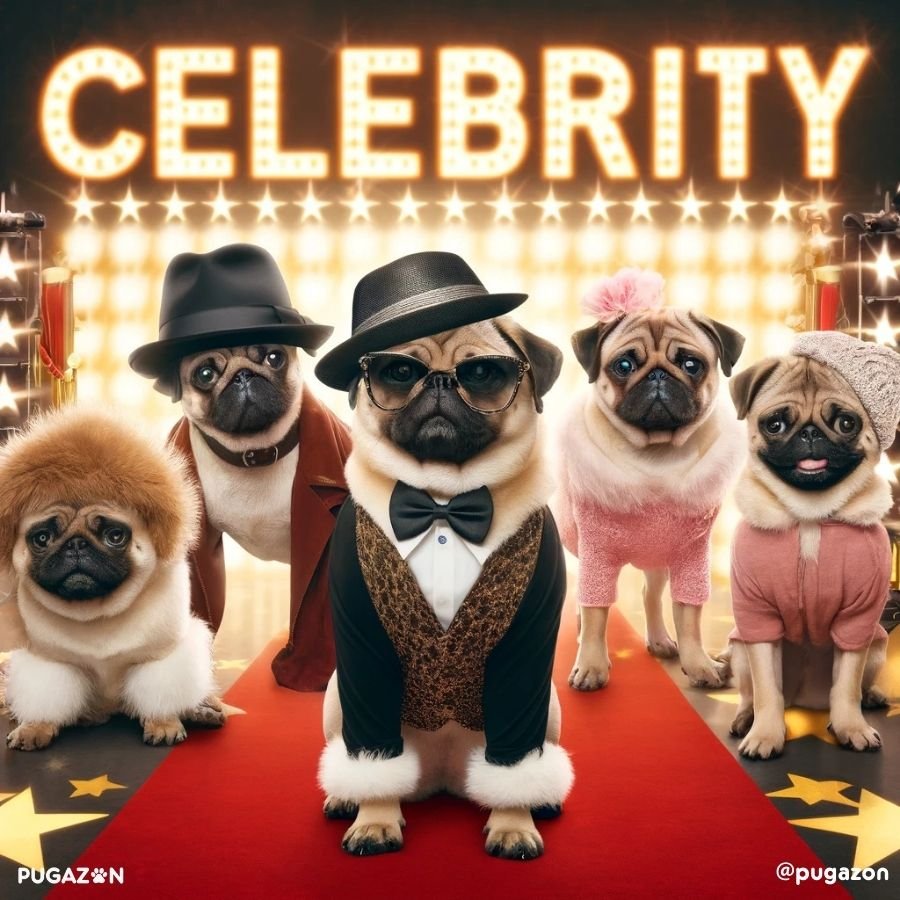
In modern times, pugs have become popular companions for celebrities, further solidifying their status as a breed favored by the elite. Their playful personalities and distinct appearance have made them a staple in the homes of fashion icons, actors, and musicians alike. Celebrity pugs often share the spotlight with their famous owners, making them instantly recognizable and beloved by fans around the world.
One of the most famous celebrity pugs is Mimi LaRue, the beloved companion of actress Tori Spelling. Mimi LaRuewas often seen on red carpets and in photoshoots, becoming a fashion icon in her own right. With her stylish outfits and appearances in magazines, Mimi LaRue exemplified the glamorous lifestyle associated with celebrity pugs.
Other notable pug owners include Jessica Alba, whose pugs Sid and Nancy often made headlines for their adorable antics. These pugs became part of Alba’s public image, frequently appearing in family photos and media interviews. The presence of pugs in the lives of celebrities like Alba and Spelling demonstrates the breed’s continued popularity among the elite.
Beyond their roles as companions, pugs in celebrity culture have also influenced fashion trends. Their presence in high-profile fashion campaigns, alongside their stylish owners, has helped cement their status as symbols of luxury and refinement. Whether they are attending a red-carpet event or lounging in a celebrity’s Instagram feed, celebrity pugs have become a key part of pop culture.
Fun Fact: Mimi LaRue, the pug owned by Tori Spelling, was so popular that she was featured on the cover of Modern Dog Magazine, making her one of the most recognizable pugs in celebrity culture.
Oliver the Pug: Valentino’s Fashionable Companion

Valentino Garavani, the legendary Italian fashion designer, is known not only for his luxurious and timeless designs but also for his deep affection for pugs. Among the pugs he has owned, Oliver the Pug became a beloved and recognizable presence in the world of high fashion, often accompanying Valentino to events and serving as a constant companion.
Valentino’s love for pugs is well-known, and Oliver was frequently by his side during fashion shows, public appearances, and even casual moments captured by the media. Oliver, along with other pugs owned by Valentino, became a staple in the designer’s life, embodying the loyalty and affection that pugs are known for.
In honor of his bond with Oliver, Valentino even named a line of clothing after his beloved pug, showcasing the important role Oliver played in his life. While there is no direct evidence that Oliver inspired specific elements of Valentino’s fashion collections, the deep connection Valentino had with his pugs undoubtedly influenced his personal and professional image. Valentino’s affection for his pugs, including Oliver, was well-documented, and they became an inseparable part of his public persona.
Oliver, like many other celebrity pugs, represented more than just a pet; he was a symbol of Valentino’s refined yet playful lifestyle, mirroring the elegance and charm that the designer brought to his creations. Oliver the Pug remains an iconic part of Valentino’s legacy, illustrating how the designer’s love for pugs extended beyond the runway and into his everyday life.
Fun Fact: Oliver the Pug was such an integral part of Valentino’s life that he named a clothing line after him, further cementing Oliver’s place in both the designer’s heart and the fashion world.
FAQs About Iconic Pugs in History
Pugs originated in ancient China, where they were bred to be companions for the imperial family. The breed has existed for over 2,000 years and was highly regarded for its distinctive features, such as its flat face, curly tail, and affectionate nature. Pugs were considered symbols of wealth and protection in ancient Chinese courts.
Lamb and Moss, two pugs brought from China to England in the early 19th century, are credited with laying the foundation for modern English and American pug lines. Their offspring, including Click, played a crucial role in shaping the breed’s characteristics, such as the wrinkled face and compact body, which are still highly valued in pugs today.
Pugs were beloved by many royal figures, including Marie Antoinette, Josephine Bonaparte, and Queen Victoria. Marie Antoinette had a pug named Mops, who traveled with her from Austria to France, while Josephine Bonaparte’s pug, Fortune, played a vital role in her life, even helping her communicate with Napoleon during her imprisonment. Queen Victoria owned several pugs and helped popularize the breed during the Victorian era.
Pompey the Pug saved the life of Prince William of Orange during an assassination attempt. Pompey alerted the prince to the approaching assassins by barking and scratching, allowing him to escape in time. Pompey’s bravery earned him a place in pug history as a loyal and heroic companion.
In Europe, pugs were favored by royalty and aristocrats due to their distinctive appearance and loyal nature. Pugs were often seen in royal courts, including the courts of Holland and France, where they were treated as symbols of luxury and refinement. Their presence in aristocratic portraits further solidified their status as a breed associated with wealth and nobility.
In recent times, pugs have become popular companions for celebrities and fashion icons. One of the most famous pug owners is Valentino Garavani, who often brought his pug Oliver to fashion events. Mimi LaRue, the pug owned by Tori Spelling, also became a well-known figure in celebrity culture, frequently appearing on red carpets and magazine covers.
Yes, Josephine Bonaparte’s pug, Fortune, played a crucial role in communicating with Napoleon during her imprisonment. She would tuck secret messages inside Fortune’s collar, and the pug would deliver them to Napoleon. This act of loyalty further solidified the pug’s reputation as a symbol of devotion and companionship.
Pugs were adored by European royalty for their affectionate nature and regal appearance. Their small size, wrinkled faces, and curly tails made them ideal companions for aristocrats. The breed’s association with royal figures like Marie Antoinette and Queen Victoria elevated its status, making pugs highly sought after by the European elite.
Yes, one of the most famous pugs in art history is Trump, the pug owned by William Hogarth, a renowned 18th-century English painter. Trump appeared in several of Hogarth’s paintings, including the famous self-portrait The Painter and His Pug, symbolizing loyalty and companionship. Pugs were also commonly featured in aristocratic portraits during the 18th and 19th centuries.
The pug’s reputation for loyalty stems from their early role as companions to Chinese emperors and European royalty. Stories like that of Pompey the Pug, who saved Prince William of Orange, and Fortune, who helped Josephine Bonaparte, have cemented the pug’s status as a symbol of loyalty and protection throughout history.


